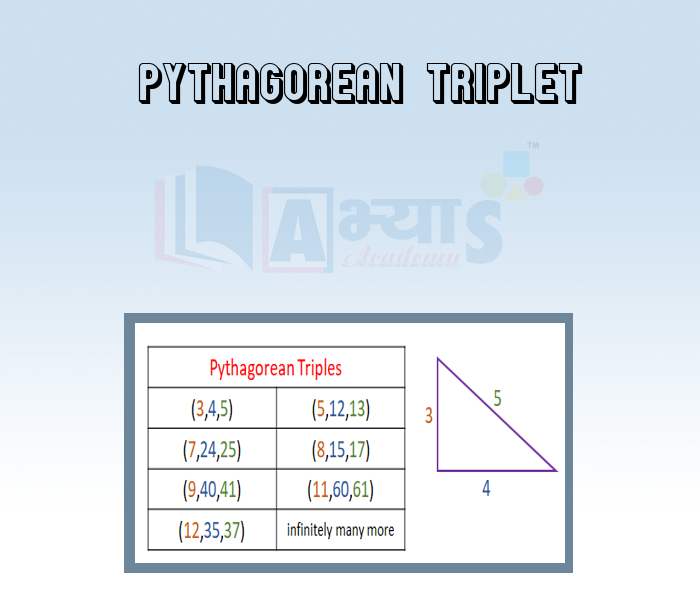Pythagorean Triplet







Pythagorean Triplet
Property :For any natural number m greater than 1 the Pythagorean triplet are represented as
Proof: In order to prove that is a Pythagorean triplet, it is sufficient to prove that
We have,
Hence, is Pythagorean triplet for any natural number m > 1.
Remark: If m and n are relatively prime natural numbers such that m > n and exactly one of them is even and other is odd, then is a primitive Pythagorean triple.
Here, the word primitive means that the three numbers contain no common factor.
Illustration: Write a Pythagorean triplet whose one member is:
(i) 6 (ii) 18
Solution: For any natural number m > 1, we have
as a Pythagorean triplet.
(i) Here,
and
Hence the pythagorean triplet is (6,8,10)
(ii) Here,
and
Hence the pythagorean triplet is (18,80,82)
Whether (13,84,85) is a pythagporean triplet ? | |||
| Right Option : A | |||
| View Explanation | |||
Which one of the triplets given below is not Pythagorean triplet ?
| |||
| Right Option : A | |||
| View Explanation | |||
Choose a Pythagorean triplet whose one member is 15 | |||
| Right Option : B | |||
| View Explanation | |||
Students / Parents Reviews [10]
My experience with Abhyas academy is very good. I did not think that my every subject coming here will be so strong. The main thing is that the online tests had made me learn here more things.

Hiya Gupta
8thMy experience was very good with Abhyas academy. I am studying here from 6th class and I am satisfied by its results in my life. I improved a lot here ahead of school syllabus.

Ayan Ghosh
8thA marvelous experience with Abhyas. I am glad to share that my ward has achieved more than enough at the Ambala ABHYAS centre. Years have passed on and more and more he has gained. May the centre flourish and develop day by day by the grace of God.

Archit Segal
7thOne of the best institutes to develope a child interest in studies.Provides SST and English knowledge also unlike other institutes. Teachers are co operative and friendly online tests andPPT develope practical knowledge also.

Aman Kumar Shrivastava
10thAbhyas is a complete education Institute. Here extreme care is taken by teacher with the help of regular exam. Extra classes also conducted by the institute, if the student is weak.

Om Umang
10thI have spent a wonderful time in Abhyas academy. It has made my reasoning more apt, English more stronger and Maths an interesting subject for me. It has given me a habbit of self studying

Yatharthi Sharma
10thMy experience with Abhyas is very good. I have learnt many things here like vedic maths and reasoning also. Teachers here first take our doubts and then there are assignments to verify our weak points.

Shivam Rana
7thAbhyas Methodology is very good. It is based on according to student and each child manages accordingly to its properly. Methodology has improved the abilities of students to shine them in future.

Manish Kumar
10thBeing a parent, I saw my daughter improvement in her studies by seeing a good result in all day to day compititive exam TMO, NSO, IEO etc and as well as studies. I have got a fruitful result from my daughter.

Prisha Gupta
8thIt was a good experience with Abhyas Academy. I even faced problems in starting but slowly and steadily overcomed. Especially reasoning classes helped me a lot.
